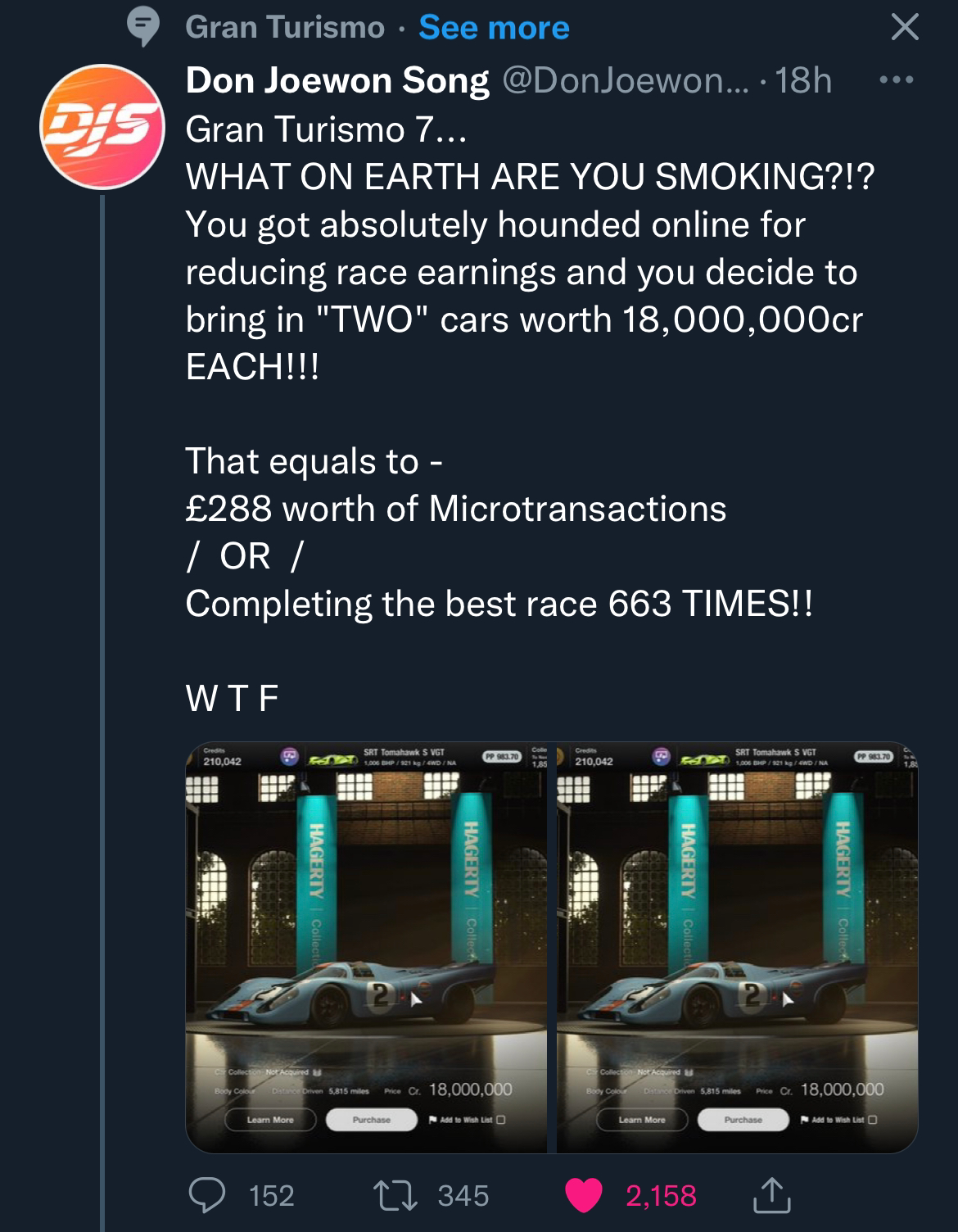Consulting GTPlanet’s own GTPEDIA, it’s easy to see why there were questions about GT7’s economy setup. Even at launch, it ranked among the slowest of the full-price titles — though the rate of earning credits was firmly mid-pack.
Taking the “most effective tactic available” (or “meta”) for each game in the series, the approximate credit earning potential ranked GT7 at third overall:
Gran Turismo 6 – 3.55m credits/hr
Gran Turismo Sport – 2.04m credits/hr
Gran Turismo 7 (v1.06) – 1.75m credits/hr
Gran Turismo 4 – 1.69m credits/hr
Gran Turismo 2 – 1.35m credits/hr
Gran Turismo 5 – 0.87m credits/hr
Gran Turismo 7 (v1.07) – 0.85m credits/hr
Gran Turismo 3 – 0.50m credits/hr
Gran Turismo 1 – 0.50m credits/hr
However that’s only taking GT5 and GT6 into consideration in their end-state, after the servers had closed. During their active periods, both had regular online events that paid out millions of credits each time, which in GT6’s case effectively rendered the microtransactions irrelevant – and it already had the highest earning potential.
Part of this came from being able to sell vehicles, with certain events being more lucrative due to the repeat rewards of pricey prize vehicles. This feature is not present in either GT Sport or GT7 — even though the official PlayStation Store page for GT7 implies that it is.
With the change to the race payouts in v1.07, GT7 plunges to sixth on the list, ahead of only GT3 and GT1.
Earning credits is only half the picture of a game economy though, because you also need to spend them! This is where the game economy of GT Sport and GT7 start to come apart somewhat.
In early GT games, the most expensive cars ran to seven figures only — in fact only 500,000cr in GT1 — and there weren’t all that many of them. When GT5 hit, it included several eight-figure cars, including the now-standard 20,000,000cr vehicles that form the game “unicorns”. GT Sport alone had four of these cars, with another six between 10m and 20m credits.
That meant that GT Sport had the most expensive full car list in Gran Turismo history, despite having a quarter of the roster of GT6. More importantly it meant that the “meta” became a grind for credits, with players driving the same event for hours to score even one of the game’s most expensive cars.
While we haven’t yet seen the pricing of GT7’s highest-priced cars, it looks to be slightly less expensive generally. The 20m credit Jaguar XJ13 and Ford MkIV have been available in the Legends Cars dealer for a combined 14.6m credits, though pre-launch screenshots showed the Mercedes S Barker Tourer was in the 20m credit club. Prices may vary thanks to the association with Hagerty, but with that and the credit cap we can assume 20m cars are back.
Taking these prices into account results in a pretty stark picture of just how much of a grind the PS4/PS5 titles are in terms of time taken to buy just one example of the most expensive vehicles in each game:
Gran Turismo 1 – 1 hour (8 races)
Gran Turismo 2 – 1.5 hours (14 races)
Gran Turismo 4 – 2.7 hours (32 races)
Gran Turismo 6 – 5.8 hours (90 races)
Gran Turismo 3 – 7.5 hours (5 races)
Gran Turismo Sport – 9.9 hours (84 races)
Gran Turismo 7 (v1.06) – 10.9 hours (205 races)
Gran Turismo 7 (v1.07) – 17.8 hours (333 races)
Gran Turismo 5 – 23.3 hours (315 races)
Again though, this doesn’t reflect the fact that GT5 and GT6 had daily login bonus boosts and quicker ways of earning credits through seasonal events during their active life. That would promote both games up the list, with GT5 eclipsing Sport and 7 during its heyday.
One additional factor here is the cost of upgrading cars. This in-demand feature returned to GT7 in a more comprehensive manner than ever before, and that contributes towards our feeling that in terms of the game alone it’s the best title yet. But parts — and more parts than previous titles — are expensive, and it pushes GT7’s economy further out of step compared to even GT Sport.
[PS5/PS4]Gran Turismo 7 跑車浪漫旅 7 集中討論區 4
153小妹(真絲)
1001 回覆
1 Like
40 Dislike
第 1 頁第 2 頁第 3 頁第 4 頁第 5 頁第 6 頁第 7 頁第 8 頁第 9 頁第 10 頁第 11 頁第 12 頁第 13 頁第 14 頁第 15 頁第 16 頁第 17 頁第 18 頁第 19 頁第 20 頁第 21 頁第 22 頁第 23 頁第 24 頁第 25 頁第 26 頁第 27 頁第 28 頁第 29 頁第 30 頁第 31 頁第 32 頁第 33 頁第 34 頁第 35 頁第 36 頁第 37 頁第 38 頁第 39 頁第 40 頁第 41 頁
賽車真係玩Assetto啦
可惜得GT3 GT4個啲
佢有埋SUPER GT我真係頭也不回
可惜得GT3 GT4個啲
佢有埋SUPER GT我真係頭也不回

點較先1.5 way
其實真係會有人特登去刷咁耐錢就係為左買部車返黎擺架咩? 
我只可以話你正常咁玩, 只買你想渣既車改你想玩既車,
D 錢基本上都 "一定夠用"
除左某幾部經典既真係自己鐘意既之外,
我真係從第一日開始就冇買果堆過千萬既 legendary car 既念頭

我只可以話你正常咁玩, 只買你想渣既車改你想玩既車,
D 錢基本上都 "一定夠用"
除左某幾部經典既真係自己鐘意既之外,
我真係從第一日開始就冇買果堆過千萬既 legendary car 既念頭

用部美國2千幾匹嗰部?
跑邊個場?係咪美國個機場跑道?
跑邊個場?係咪美國個機場跑道?
每個人有唔同方法去享受隻game
數據亦講咗今集最難買貴車 再加上 想靠自己玩黎賺錢買原來係會比人nerf
數據亦講咗今集最難買貴車 再加上 想靠自己玩黎賺錢買原來係會比人nerf
GT一部PS先會出一集
玩撚到出PS6
慢慢玩

玩撚到出PS6
慢慢玩



GT5 showroom錯圖

係

GT6睇返真係顛峰嚟,成1200架車
只係決定錯左出左喺PS3
只係決定錯左出左喺PS3

大半重複車或者得個殼
GT4 先係顛峰
GT4 先係顛峰
2,4

GT4個物理玩到我好頹
只係勝在有香港賽道
玩得最癲都係GT5

只係勝在有香港賽道
玩得最癲都係GT5
隻game 係咪要重課先得?見揸好多轉先會賺錢

以前一部GT3出都幾部當幾架



MX5 十幾部

MC 1.8



其實係咪要重課先得

隻game唔係pay to win
買啲普通車都算ok
除非你想齊車, 或者你想要果啲車係經典古董車
買啲普通車都算ok
除非你想齊車, 或者你想要果啲車係經典古董車
強迫症發作咪想儲車

玩最後個championship仲正
最後兩場有一半係夜晚
我開super formula冇頭燈
要開racing line先玩到
最後兩場有一半係夜晚
我開super formula冇頭燈
要開racing line先玩到

好彩啲GT500個價都仲算合理,負擔得到
係唔知架仲未出現既GT-R '99咩環境
係唔知架仲未出現既GT-R '99咩環境

